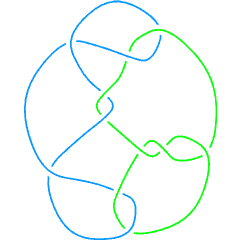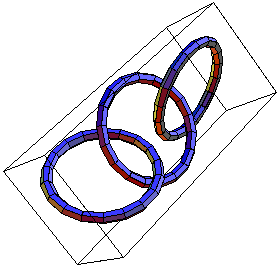0708-1300/Homework Assignment 6: Difference between revisions
No edit summary |
No edit summary |
||
| Line 14: | Line 14: | ||
==Doing== |
==Doing== |
||
Solve the following problems and submit your solutions of problems |
Solve the following problems and submit your solutions of problems 2, 3 and 4. This is a very challenging collection of problems; I expect most of you to do problem 1 with no difficulty (it is a repeat of an older problem), problem 2 with some effort, and I hope each of you will be able to do at least one further problem. It will be great if some of you will do all problems! |
||
'''Problem 1.''' |
'''Problem 1.''' The standard volume form on <math>S^2</math> is the form <math>\omega</math> given by <math>\omega=\frac{1}{4\pi}\left(xdy\wedge dz+ydz\wedge dx+zdx\wedge dy\right)</math>. Show that <math>\int_{S^2}\omega=1</math>. |
||
'''Problem 2.''' |
'''Problem 2.''' If <math>M</math> is a compact orientable <math>n</math>-manifold with no boundary, show that <math>H^n_{dR}(M)\neq 0</math>. |
||
'''Problem 3.''' Show that if <math>\omega\in\Omega^2(S^2)</math> satisfies <math>\int_{S_2}\omega=0</math>, then <math>\omega</math> is exact. Deduce that if <math>w_1\in\Omega^2(S^2)</math> and <math>w_2\in\Omega^2(S^2)</math> satisfy <math>\int_{S_2}\omega_1=\int_{S_2}\omega_2</math>, then <math>[\omega_1]=[\omega_2]</math> as elements of <math>H^2_{dR}(S^2)</math>. Deduce further that <math>\dim H^2_{dR}(S^2)=1</math>. |
'''Problem 3.''' Show that if <math>\omega\in\Omega^2(S^2)</math> satisfies <math>\int_{S_2}\omega=0</math>, then <math>\omega</math> is exact. Deduce that if <math>w_1\in\Omega^2(S^2)</math> and <math>w_2\in\Omega^2(S^2)</math> satisfy <math>\int_{S_2}\omega_1=\int_{S_2}\omega_2</math>, then <math>[\omega_1]=[\omega_2]</math> as elements of <math>H^2_{dR}(S^2)</math>. Deduce further that <math>\dim H^2_{dR}(S^2)=1</math>. |
||
Revision as of 09:47, 6 December 2007
| ||||||||||||||||||||||||||||||||||||||||||||||||||||||||||||||||||||||||||||||||||||||||||||||||||||||||||||
Reading
At your leisure, read your class notes over the break, and especially at some point right before classes resume next semester. Here are a few questions you can ask yourself while reading:
- Do you understand pullbacks of differential forms?
- Do you think you could in practice integrate any differential form on any manifold (at least when the formulas involved are not too messy)?
- Do you understand orientations and boundaries and how they interact?
- Why is Stokes' theorem true? Both in terms of the local meaning of , and in terms of a formal proof.
- Do you understand the two and three dimensional cases of Stokes' theorem?
- Do you understand the Hodge star operator ?
- How did we get from the least action principle?
- Do you understand how Poincare's lemma entered the derivation of Maxewell's equations?
- Do you understand the operator ? (How was it used, formally derived, and what is the intuitive picture behind it?)
- What was and how did it relate to pullbacks and homotopy.
Doing
Solve the following problems and submit your solutions of problems 2, 3 and 4. This is a very challenging collection of problems; I expect most of you to do problem 1 with no difficulty (it is a repeat of an older problem), problem 2 with some effort, and I hope each of you will be able to do at least one further problem. It will be great if some of you will do all problems!
Problem 1. The standard volume form on is the form given by . Show that .
Problem 2. If is a compact orientable -manifold with no boundary, show that .
Problem 3. Show that if satisfies , then is exact. Deduce that if and satisfy , then as elements of . Deduce further that .
Problem 4. A "link" in is an ordered pair , in which and are smooth embeddings of the circle into , whose images (called "the components of ") are disjoint. Two such links are called "isotopic", if one can be deformed to the other via a smooth homotopy along which the components remain embeddings and remain disjoint. Given a link , define a map by . Finally, let be the standard volume form of , and define "the linking number of " to be . Show
- If two links and are isotopic, then their linking numbers are the same: .
- If is a second 2-form on for which and if is defined in the same manner as except replacing with , then . (In particular this is true if is very close to a -function form at the north pole of ).
- Compute (but just up to an overall sign) the linking number of the link L11a193, displayed below:

|

|

|
| The links L11a193, and . | ||
Just for Fun
Prove that the two (3-component) links and shown above are not isotopic, yet their complements are diffeomorphic. (See more at Classes: 2004-05: Math 1300Y - Topology: Homework Assignment 5)
Due Date
This assignment is due in class on Thursday January 10, 2007.


















![{\displaystyle [\omega _{1}]=[\omega _{2}]}](https://wikimedia.org/api/rest_v1/media/math/render/svg/6a072623e3514df1499ca42d8c579fc667748e42)




















